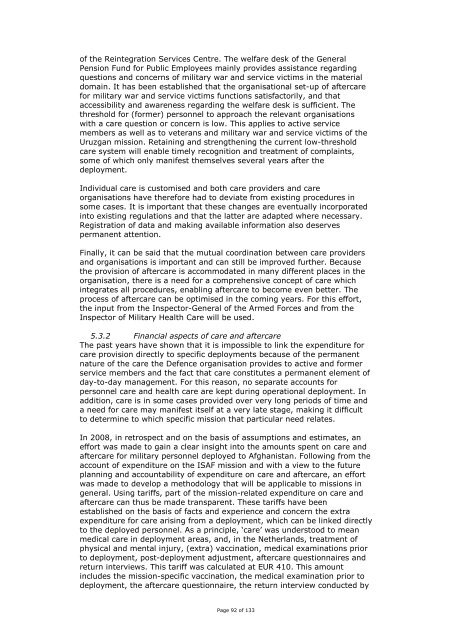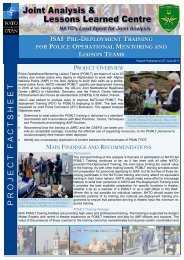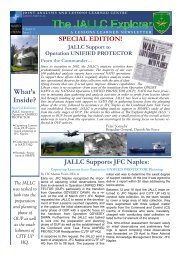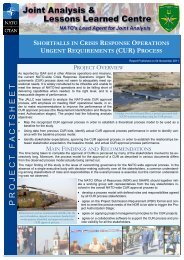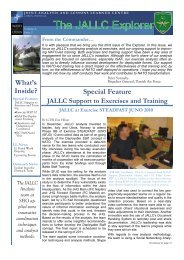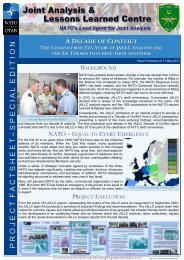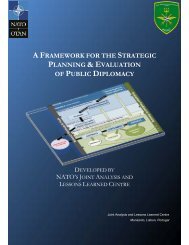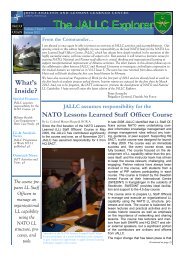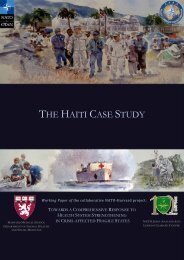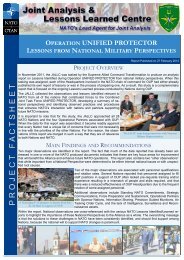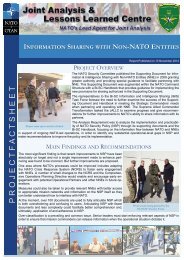Final evaluation Netherlands participation in ISAF 2006 - 2010
Final evaluation Netherlands participation in ISAF 2006 - 2010
Final evaluation Netherlands participation in ISAF 2006 - 2010
You also want an ePaper? Increase the reach of your titles
YUMPU automatically turns print PDFs into web optimized ePapers that Google loves.
of the Re<strong>in</strong>tegration Services Centre. The welfare desk of the GeneralPension Fund for Public Employees ma<strong>in</strong>ly provides assistance regard<strong>in</strong>gquestions and concerns of military war and service victims <strong>in</strong> the materialdoma<strong>in</strong>. It has been established that the organisational set-up of aftercarefor military war and service victims functions satisfactorily, and thataccessibility and awareness regard<strong>in</strong>g the welfare desk is sufficient. Thethreshold for (former) personnel to approach the relevant organisationswith a care question or concern is low. This applies to active servicemembers as well as to veterans and military war and service victims of theUruzgan mission. Reta<strong>in</strong><strong>in</strong>g and strengthen<strong>in</strong>g the current low-thresholdcare system will enable timely recognition and treatment of compla<strong>in</strong>ts,some of which only manifest themselves several years after thedeployment.Individual care is customised and both care providers and careorganisations have therefore had to deviate from exist<strong>in</strong>g procedures <strong>in</strong>some cases. It is important that these changes are eventually <strong>in</strong>corporated<strong>in</strong>to exist<strong>in</strong>g regulations and that the latter are adapted where necessary.Registration of data and mak<strong>in</strong>g available <strong>in</strong>formation also deservespermanent attention.<strong>F<strong>in</strong>al</strong>ly, it can be said that the mutual coord<strong>in</strong>ation between care providersand organisations is important and can still be improved further. Becausethe provision of aftercare is accommodated <strong>in</strong> many different places <strong>in</strong> theorganisation, there is a need for a comprehensive concept of care which<strong>in</strong>tegrates all procedures, enabl<strong>in</strong>g aftercare to become even better. Theprocess of aftercare can be optimised <strong>in</strong> the com<strong>in</strong>g years. For this effort,the <strong>in</strong>put from the Inspector-General of the Armed Forces and from theInspector of Military Health Care will be used.5.3.2 F<strong>in</strong>ancial aspects of care and aftercareThe past years have shown that it is impossible to l<strong>in</strong>k the expenditure forcare provision directly to specific deployments because of the permanentnature of the care the Defence organisation provides to active and formerservice members and the fact that care constitutes a permanent element ofday-to-day management. For this reason, no separate accounts forpersonnel care and health care are kept dur<strong>in</strong>g operational deployment. Inaddition, care is <strong>in</strong> some cases provided over very long periods of time anda need for care may manifest itself at a very late stage, mak<strong>in</strong>g it difficultto determ<strong>in</strong>e to which specific mission that particular need relates.In 2008, <strong>in</strong> retrospect and on the basis of assumptions and estimates, aneffort was made to ga<strong>in</strong> a clear <strong>in</strong>sight <strong>in</strong>to the amounts spent on care andaftercare for military personnel deployed to Afghanistan. Follow<strong>in</strong>g from theaccount of expenditure on the <strong>ISAF</strong> mission and with a view to the futureplann<strong>in</strong>g and accountability of expenditure on care and aftercare, an effortwas made to develop a methodology that will be applicable to missions <strong>in</strong>general. Us<strong>in</strong>g tariffs, part of the mission-related expenditure on care andaftercare can thus be made transparent. These tariffs have beenestablished on the basis of facts and experience and concern the extraexpenditure for care aris<strong>in</strong>g from a deployment, which can be l<strong>in</strong>ked directlyto the deployed personnel. As a pr<strong>in</strong>ciple, ‘care’ was understood to meanmedical care <strong>in</strong> deployment areas, and, <strong>in</strong> the <strong>Netherlands</strong>, treatment ofphysical and mental <strong>in</strong>jury, (extra) vacc<strong>in</strong>ation, medical exam<strong>in</strong>ations priorto deployment, post-deployment adjustment, aftercare questionnaires andreturn <strong>in</strong>terviews. This tariff was calculated at EUR 410. This amount<strong>in</strong>cludes the mission-specific vacc<strong>in</strong>ation, the medical exam<strong>in</strong>ation prior todeployment, the aftercare questionnaire, the return <strong>in</strong>terview conducted byPage 92 of 133


